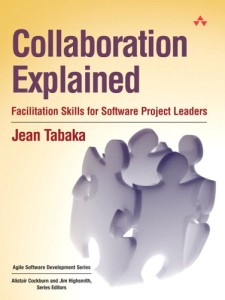
A vibrant depiction of interconnected multicolored spheres linked by thin lines, symbolizing digital networks, global communication, and teamwork. ideal for illustrating concepts of technology, connectivity, and collaborative innovation. Generative AI
Collaboration Explained: Facilitation Skills for Software Project Leaders
 This book is from one of my favorite people in the Agile community, Jean Tabaka. Jean is a Agile Fellow at Rally and wrote one of the key books that influenced me in my thinking about Scrum. For me, the ideas, concepts and techniques in this book are fundamental to being a good ScrumMaster. Any ScrumMaster, or team leader, who cannot master these techniques has no business in this role. The good news is that Jean lays out very clearly how to perform these fundamental facilitation techniques in her easy-to-read, accessible book. Finally, what makes this book such a pleasure to read are Jean’s anecdotes liberally sprinkled throughout the book discussing her successes (and failures) as a collaborative leader.
This book is from one of my favorite people in the Agile community, Jean Tabaka. Jean is a Agile Fellow at Rally and wrote one of the key books that influenced me in my thinking about Scrum. For me, the ideas, concepts and techniques in this book are fundamental to being a good ScrumMaster. Any ScrumMaster, or team leader, who cannot master these techniques has no business in this role. The good news is that Jean lays out very clearly how to perform these fundamental facilitation techniques in her easy-to-read, accessible book. Finally, what makes this book such a pleasure to read are Jean’s anecdotes liberally sprinkled throughout the book discussing her successes (and failures) as a collaborative leader.
For me, collaboration is this concept when you add two plus two you get something greater than the simple sum – you might get five, eight or even twelve! Collaboration is the idea that we build upon the talents and gifts of each individual to develop something emergent, remarkable and could not have been predicted in advance. In contrast, the pale, cheap knock-off of collaboration is cooperation. As I think about it, cooperation is the concept that two plus two will produce four and the final outcome can be predicted in advance by reviewing each of the individual components.
To an inexperienced ScrumMaster, project manager or team leader, cooperation and collaboration appear to be the same thing. As long as people get along – cooperation – that is good enough. However, that is not what we are striving to achieve in Scrum. IMO, one of the central goals of Scrum is to integrate the various perspectives, experiences and ideas of each member of the Team with the needs of the customer to produce an astonishing outcome. An outcome or result that is simply revolutionary and disruptive while being extremely elegant and efficient in form and function.
Often times, you can observe collaboration in meetings, but it should occur everywhere. It is the job of the collaborative leader to create an environment where people collaborate day–to-day in their personal interactions. Since Scrum is a team-based framework, the participants learn how to collaborate day-to-day by practicing the collaborative techniques in meetings. ScrumMasters are responsible to facilitate all the Scrum meetings and serve as a resource for the Team to facilitate any other meeting the Team needs help with, the ScrumMaster models collaboration and creates and maintains the collaborative environment.
To the inexperienced, collaboration looks like magic – sometimes you get the right people together and it works out and other times the interactions are a dud and the meeting a failure. However, and experienced facilitator knows this is not true. There is no magic to collaboration, just a great deal of planning and preparation on part of the facilitator AND the meeting participants. Jean’s book will prepare you to be a collaborative leader, to accept the responsibilities as process owner and help you manage participant dynamics in a variety of situations, including with distributed Teams.
The first chapters of this book you need to read is not Chapter One, but Chapter Seven and Eight. In this chapter, Jean discusses the importance of preparing the participants to collaborate. In her opinion (and I agree with here), the most important question that must be answered before you even consider the agenda is:
What is the purpose of this meeting?
If you cannot answer this question with a brief, direct statement, you have no reason to gather people together to meet. In addition, the purpose of the meeting must be compelling enough for each participant to take a break from their day-to-day activities and focus on the conversation at this meeting. Once you understand the meeting purpose, defining the agenda, selecting the participants and surveying the participants in advance of the meeting is a pretty straight-forward activity.
Next, I suggest moving into Chapters One to Four for a discussion on what is collaboration, how to foster a collaborative culture, how to be a collaborative leader and how to support collaborative teams. These are the chapters you need to read to better understand what is collaboration from Jean’s perspective. I would also suggest reading Chapter Eight while reading these initial chapters since this chapter provides the basic tools needed to support collaboration – meeting purpose, agenda, ground rules, parking lot, action plan, decision board, communication plan and ways to reach consensus.
When you are complete with those chapters, there are three practical chapters around facilitation – Chapters Twelve, Thirteen and Twenty. Chapter Twelve describes the differences between listing and brainstorming and offers multiple techniques to facilitate both activities. Chapter Thirteen teaches you how facilitate in group dialogue and small group activities. The final chapter – Twenty – reviews how to close a meeting and move to action. Many people do not leave enough time for this very important step and Jean gives you instructions on what needs to be done and when.
The last chapters I recommend reading in this book are Chapters Ten and Eighteen. Chapter Ten reviews the basic mechanics of setting up the meeting space, getting ready for your collaborative meeting and those first moments when people walk in the door. Chapter Eighteen offers specific techniques to manage the interactions and dealing with difficult dynamics during the meeting in very specific ways. Here is where I feel Jean’s anecdotes are quite helpful since they provide actual examples and her response to those situations.
Finally, if you need help creating collaborative meeting agendas, Jean offers up specific agendas you can apply if you are doing Scrum, Extreme Programming or just want to make your standard project meetings more collaborative. This book has just got it all!





